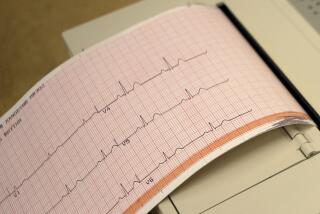They Stuck a Tow in the Water and Struck Gold
- Share via
When Amy Van Dyken became a surprise gold medalist in the 100-meter butterfly last week, her cheerleaders weren’t only in the stands. Back in Colorado Springs, Colo., engineers at the Sport Science Technology Lab, where Van Dyken had trained, were elated as well. It was Tom Westenburg, a design engineer at the lab, and Marty Hull, an inventor from Palo Alto, who designed the tow system Van Dyken used to help streamline her stroke.
The system, designed for short-distance swimmers, uses a harness that pulls swimmers through the water. An underwater camera tracks her motion as she swims up and down the pool. Because they are being pulled, swimmers can rotate their arms and legs faster. This helps them figure out how to synchronize the motion between the upper and lower body once they begin swimming faster on their own.
In Van Dyken’s case, she used the system to figure out which positions propelled her through the water fastest. Swimmers at the next Summer Games in Sydney, Australia, will get even more help from being towed. Hewlett-Packard has developed a way to take information from electronic sensors, send it through an IBM computer and make a graph that is superimposed on the videotape from the underwater camera. Watching the video, a swimmer sees instantly how much drag is created when she puts her head up or rotates her body in a particular way.
*
Take Your Atlas and Umbrella: According to Mark Twain, everybody talks about the weather, but nobody does anything about it. One problem is that there’s never been a consistent, accurate way to analyze rainfall data, which made it difficult--if not impossible--to predict the 1987-89 drought in the Great Plains or the disastrous flooding in the Midwest in 1993.
The National Drought Atlas, developed for the Army Corps of Engineers by researchers at IBM’s Thomas J. Watson Research Center in Yorktown Heights, N.Y., in conjunction with researchers at several other institutions, may be able to do something about it. Knowing about rainfall patterns would be of vital interest to farmers, local water managers and scientists studying climate changes.
While no one--not even the local weather forecaster--can predict the specific time or location of droughts or floods, a look at past rainfall records can offer important clues.
The data come from the U.S. National Climatic Data Center in Asheville, N.C., which has kept precipitation records that go back 85 years on average. Straight statistics, however, tend to be overly sensitive to anomalies, such as a month with higher-than-average rain followed by a month with no rain. But using a statistical technique called linear moments, researchers were able to sharply cut down on uncertainties. Equally important, the National Drought Atlas groups rainfall records from different places that have similar patterns. This gives greater statistical power to the estimates. A PC-based atlas for the entire United States is available on CD-ROM from Teqnical Services Inc. of New London, Conn.
*
Needling Tumors: Researchers at the Massachusetts Institute of Technology have developed a needle with a special thread--a thin strip of microchips--that provides information about cancerous tumors. When the needle is inserted into a tumor, the chips sense the temperature of the tumor, process the information and digitize it so it can be read by a computer. A master chip near the head of the needle coordinates the data flowing between the sensors and the computer. The needle, which is in prototype stage, would be less expensive than current probes and is 30% smaller in diameter.
The needle was originally developed for use in the hyperthermic treatment of cancer, in which heat is used to improve the effectiveness of radiation and chemotherapy. The goal now is to build a needle that measures not only temperature but acidity, oxygen concentration and radiation dosage. This information could be used to measure the growth rate of the tumor and its likely response to chemotherapy.
*
Human Maintenance: Humans and machines have at least one thing in common: They suffer from system failures. In humans, these failures are called heart attacks or broken bones, but the result is the same as in machines. Neither can function properly until the failure is diagnosed and fixed.
It’s best, of course, when a potential failure is detected before it happens. Could the same technologies developed to monitor machines and prevent system failures be used to maintain human health? Answers to that question are being pursued by eight Predictive Diagnostics Teams assembled by Sandia National Laboratories in Albuquerque under the sponsorship of the Koop Foundation and the Defense Advanced Research Projects Agency.
According to Robert Hansen, chairman of Penn State’s Applied Research Laboratory and chairman of one of the teams, the same sensors and signal processors, automated reasoning systems and data fusion methods used to create smart weapons and supersensitive surveillance systems could be used to combat disease. Battlefield signal processing and acoustic sensing devices could check the status of bones easily without the use of X-rays.
A patient would insert an arm or a leg into an acoustic measuring device that would identify possible cracks or other flaws in the bone in a manner similar to the way these devices are used to find flaws in machines. In the case of cardiac patients, researchers already know that a healthy heart exhibits complex, variable activity except for the period just before and during sudden cardiac death. Complex mechanical systems also show no regularity until a fault occurs, which leads to system failure. In 10 to 15 years, heart patients could wear a wristwatch with a wireless link to a hospital that would alert doctors as soon as a patient was at risk.
Freelance writer Kathleen Wiegner can be reached at kkwrite@aol.com
More to Read
Go beyond the scoreboard
Get the latest on L.A.'s teams in the daily Sports Report newsletter.
You may occasionally receive promotional content from the Los Angeles Times.






